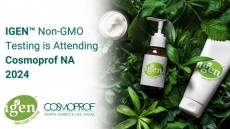Estée Lauder patents a new approach to lipofuscin treatment

Estée Lauder Companies has filed a new patent that addresses one of the most challenging aspects of skin aging—lipofuscin, or "age pigment." This patent introduces a novel composition designed to target lipofuscin accumulation in the skin, which is strongly associated with the appearance of age spots and other pigment-related imperfections.
The formulation holds intriguing implications for manufacturers and suppliers in the cosmetics and personal care industry, as it provides a pathway for developing innovative anti-aging skincare products.
Lipofuscin and its role in aging
Lipofuscin is a complex yellow-brown pigment that accumulates in human tissues with age and is recognized as one of the key contributors to the formation of age spots. The patent describes lipofuscin as "a complex mixture of protein and lipid derivatives, showing yellow-brown color under optical microscopes and having autofluorescence properties."
Due to its strong correlation with aging, reducing lipofuscin has long been a priority in the cosmetics industry.
However, traditional approaches to treating lipofuscin have been largely ineffective because “lipofuscin is known as a difficult pigment to remove once produced in the skin." Furthermore, there is still limited scientific understanding of the exact mechanisms responsible for its generation, making it difficult to develop targeted treatments.
The innovation: Decarboxylated oligopeptide and pyracantha extract
The new patent outlines a product composition that combines decarboxylated oligopeptides, particularly Decarboxy carnosine HCL, with Pyracantha fortuneana fruit extract. According to the filing, this combination has shown "unexpected synergistic effects on preventing or slowing lipofuscin generation and/or accumulation." This means that together, these ingredients are more effective at reducing lipofuscin than when used independently, which marks a noteworthy innovation in pigment treatment strategies.
Pyracantha, a genus of thorny evergreen shrubs, is known for its rich biological properties. The patent lists seven species, including Pyracantha fortuneana, as key sources of the fruit extract used in the composition. By utilizing this specific extract, Estée Lauder has identified an effective botanical ingredient with the potential to combat one of the most stubborn signs of aging.
Efficacy testing results
In efficacy testing, the combination of Decarboxy carnosine HCL and Pyracantha fortuneana fruit extract demonstrated results that exceeded expectations. As the patent filing highlighted, "the combination of Decarboxy carnosine HCL and Pyracantha fortuneana fruit extract has shown unexpected synergistic effects on preventing or slowing lipofuscin generation and/or accumulation."
This suggested that the formulation not only inhibits the formation of new lipofuscin but also slows the accumulation of existing pigment, which could offer more comprehensive skin care benefits than current products on the market.
For manufacturers, this is particularly significant, as it provides a clear pathway to creating products that could achieve more dramatic and noticeable anti-aging effects.
Implications for cosmetics and personal care product manufacturers
This patent presents several key opportunities for cosmetics and personal care manufacturers looking to innovate in the anti-aging space. First, the combination of Decarboxy carnosine HCL and Pyracantha fortuneana extract offers manufacturers a way to create high-performance skin care products that go beyond traditional anti-aging treatments, which could position brands at the cutting edge of pigment treatment technologies.
Second, with lipofuscin being a lesser-targeted pigment in the cosmetics industry, manufacturers that integrate this patented composition into their product lines can differentiate themselves from competitors. Offering a solution that addresses both melanin and lipofuscin could appeal to consumers seeking more comprehensive solutions to age spots and uneven skin tone.
Third, suppliers of botanical extracts, particularly Pyracantha fortuneana, may see increased demand as manufacturers look to develop products based on this patent. Ensuring a sustainable and high-quality supply of this extract will be critical to meeting the needs of the market.
Lastly, given the innovative nature of this patent and the specificity of its target (lipofuscin), products using this formulation could be positioned as part of a premium skin care line. This would allow manufacturers to create higher-margin products catering to consumers who are willing to invest in advanced, science-backed anti-aging treatments.
Challenges and considerations
While the results are promising, manufacturers should consider a few challenges before moving forward with product development. For example, as with any new cosmetic formulation, further clinical trials and consumer testing will be necessary to ensure the efficacy of these compositions in real-world conditions. Manufacturers may need to invest in additional research to refine the formulation and establish its long-term benefits.
Additionally, the inclusion of botanical extracts, such as Pyracantha fortuneana, in large-scale production could introduce complexities in sourcing and sustainability. Therefore, manufacturers and suppliers will need to collaborate closely to ensure a reliable supply chain for these ingredients, particularly as demand increases.
Finally, as lipofuscin is less well-known than melanin among consumers, manufacturers may need to invest in educational marketing campaigns to explain the unique benefits of this new product. As a result, highlighting the science behind the formulation could be key to driving consumer adoption.
Estée Lauder’s recent patent marks a noteworthy development in the cosmetics industry, particularly in the area of anti-aging skin care, and for manufacturers and suppliers in the cosmetics and personal care sectors, this patent opens the door to creating next-generation products with enhanced anti-aging and pigmentation-correcting capabilities.
By leveraging this innovation, manufacturers have the opportunity to meet growing consumer demand for more effective solutions to age-related skin concerns, all while differentiating their products in a competitive market.
















